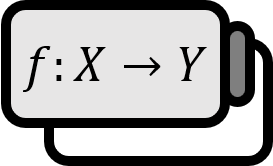逆双曲線関数
定義1
双曲線関数の逆関数を逆双曲線関数と言います。
$$ \begin{align*} y = \sinh^{-1} x &\iff \sinh y = x \\ y = \cosh^{-1} x &\iff \cosh y = x \\ y = \tanh^{-1} x &\iff \tanh y = x \\ \end{align*} $$
クローズド形式
逆双曲線関数の関数値は具体的には以下の通りです。
$$ \begin{align*} \sinh^{-1} x &= \ln \left( x + \sqrt{x^{2} + 1} \right) & x \in \mathbb{R} \\ \cosh^{-1} x &= \ln \left( x + \sqrt{x^{2} - 1} \right) & x \le 1 \\ \tanh^{-1} x &= \dfrac{1}{2} \ln \left( \dfrac{1 + x}{1 - x} \right) & -1 \lt x \lt 1 \\ \end{align*} $$
証明
$\sinh^{-1} x$
方法1
$y = \sinh^{-1} x$とする。すると$\sinh y = x$となるため、
$$ \dfrac{e^{y} - e^{-y}}{2} = x \implies e^{y} - e^{-y} - 2x = 0 $$
$e^{y}$を乗じて$e^{y}$についての二次方程式として整理しよう。
$$ (e^{y})^{2} - 2x(e^{y}) - 1 = 0 $$
解の公式で根を求めると、
$$ e^{y} = x \pm \sqrt{x^{2} + 1} $$
この時$x \le \sqrt{x^{2}} < \sqrt{x^{2} + 1}$であり、$e^{y} > 0$であるため、可能な場合は、
$$ e^{y} = x + \sqrt{x^{2} + 1} $$
両辺にログを取ると、
$$ y = \ln (x + \sqrt{x^{2} + 1}) $$
方法2
$y = \sinh^{-1} x$とする。すると$\sinh y = x$であり、$\cosh x + \sinh x = e^{x}$であるため、両辺に$\cosh y$を加えると、
$$ e^{y} = x + \cosh y $$
また、恒等式 $\cosh^{2}x - \sinh^{2}x = 1$を利用すると次を得る。
$$ e^{y} = x + \sqrt{\sinh^{2} y + 1} = x + \sqrt{x^{2} + 1} $$
両辺にログを取ると、
$$ y = \ln (x + \sqrt{x^{2} + 1}) $$
$\cosh^{-1} x$
$\sinh^{-1} x$を求めるのと同じ方法で、簡単に書くと以下の通りです。
$$ \begin{align*} && y &= \cosh^{-1} x \\ \implies && \cosh y &= x \\ \implies && \cosh y + \sinh y &= x + \sinh y \\ \implies && e^{y} &= x + \sqrt{\cosh^{2}y - 1} \\ \implies && e^{y} &= x + \sqrt{x^{2} - 1} \\ \implies && y &= \ln (x + \sqrt{x^{2} - 1}) \end{align*} $$
$\tanh^{-1} x$
説明なしに手順だけ簡単に書くと以下の通りです。
$$ \begin{align*} && y &= \tanh^{-1} x \\ \implies && \tanh y &= x \\ \implies && \dfrac{e^{y} - e^{-y}}{e^{y} + e^{-y}} &= x \\ \implies && \dfrac{e^{2y} - 1}{e^{2y} + 1} &= x \\ \implies && e^{2y} - 1 &= x (e^{2y} + 1) \\ \implies && e^{2y} - xe^{2y} &= x + 1 \\ \implies && (1 - x)e^{2y} &= x + 1 \\ \implies && e^{2y} &= \dfrac{1 + x}{1 - x} \\ \implies && y &= \dfrac{1}{2} \ln \left( \dfrac{1 + x}{1 - x} \right) \\ \end{align*} $$
定義域と値域
$$ \begin{align*} \sinh^{-1} &: \mathbb{R} \to \mathbb{R} \\ \cosh^{-1} &: [1, \infty) \to [0, \infty) \\ \tanh^{-1} &: (-1, 1) \to \mathbb{R} \end{align*} $$
導関数
$$ \begin{align*} \dfrac{d}{dx} (\sinh^{-1} x) &= \dfrac{1}{\sqrt{x^{2} + 1}} \qquad & \dfrac{d}{dx} (\csch^{-1} x) &= - \dfrac{1}{|x|\sqrt{x^{2} + 1}} \\ \dfrac{d}{dx} (\cosh^{-1} x) &= \dfrac{1}{\sqrt{x^{2} - 1}} \qquad & \dfrac{d}{dx} (\sech^{-1} x) &= - \dfrac{1}{x\sqrt{1 - x^{2}}} \\ \dfrac{d}{dx} (\tanh^{-1} x) &= \dfrac{1}{1 - x^{2}} \qquad & \dfrac{d}{dx} (\coth^{-1} x) &= \dfrac{1}{1 - x^{2}} \end{align*} $$
James Stewart, Daniel Clegg, and Saleem Watson, Calculus (early transcendentals, 9E), p261-266 ↩︎
